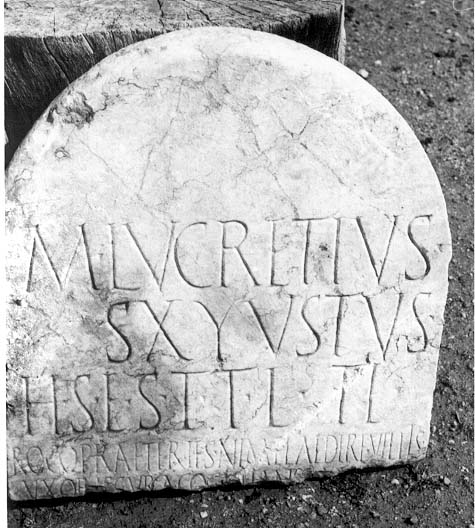Epitaph of Marcus Lucretius
Reference CIL II2/5, 1227 | Description | Lyrics | Location | Chronology | Epigraphic edition | Translation | Apparatus | Comentary | Type of verse | Text divided into verses and metric signs | Images | Bibliography | Link to DB | Author |
Epitaph of Marcus Lucretius
Description
- Idno filename 22/01/0091
- Type of inscription: Sepulcralis
- Material Description: Stele of greyish white marble.
- Conservation status: With an ornamental semicircle at the top, and broken below, with loss of lines. Polished front face; sides left rough.
- Dimensions height/width/depth (cm): 34.5/32/4.5
-
Epigraphic field:
- Layout: Good layout; triangular interpunctions with the vertex pointing downwards, separating all the words except in line 4 (ni me).
- Corpus: II2/5, 1227
- Preserved
Lyrics
- Font:Libraria
- Letter size:4,5/5 (ll. 1-3), 2,4/2,5 (ll. 4-5) cm
- Description of the letters:Larger letters in the praescriptum. The carmen begins at the end of l. 3: the pronoun te is the same size (5) as the other letters in the line, while the rest of the carmen is inscribed in much smaller and more cramped characters, occupying ll. 4 and 5.
Location
- Place of discovery: The piece is from Écija (Astigi).
- Geolocation
- Conservation location: Museo Histórico Provincial de Écija.
- Location with Modern Nomenclature España / Sevilla / Écija
- Location with Old Nomenclature Hispania / Baetica / Astigitanus / Astigi
Chronology
- Inscription's dating: Between year 100 and year 199
- Dating explanation: From the type of letter it can be dated to the 2nd c., a date which is confirmed by the formula in the verse part.
Type of verse
- Type of verse: Dactílico (ritmo)
- Verse/line correspondence: No
- Prose/verse distinction: Si
Epigraphic edition
M(arcus) ▴ Lucretius ▴
Sxyustus ▴ (!)
h(ic) ▴ s(itus) ▴ e(st) ▴ s(it) ▴ t(ibi) ▴ t(erra) ▴ l(evis) ▴ te ▴
rogo ▴ praeterie(n)s ▴ ni (!) me ▴ laedere ▴vellìs ▴ (!)
5 uxoris cura coc+6+[‑ ‑ ‑]
‑ ‑ ‑ ‑ ‑ ‑
Text divided into verses and metric signs
te rogo praeteriens ni me laedere vellis lww|lww|l||ll|lww|ll
uxoris cura coc [‑ ‑ ‑] ll|ll|l
Translation
Marcus Lucretius Sxyustus. I beg you, as you pass, do not damage me. By the good offices of my wife...
Bibliography
Martínez Ortega 1982, 295–298 (inde González Fernández, CILA II, 759, cum im. phot.; AE 1984, 524; Ordóñez Agulla 1988, 165); González Fernández, II2/5, 1227 (HEp 1997, 816); Fernández Martínez – Carande, CLEB SE14, cum im. phot, quae in linguam Hispanicam verterunt; Cugusi 2012, 51. – Cf. Hernández Pérez 2001a, 136.
Apparatus
2 pro Sxyustus Canto in HEp maluit S(e)x(ti f) Iustus. – 4 ni me lapis, nimis? Martínez Ortega. – 5 uxoris cura coc+[-l?–] ++ an- [-2–] González Fernández CILA, uxoris cura . CO++[-1?-]++AN+[-2?-]++[-8?-] González Fernández II2/5.
Comentary
Epitaph to Marcus Lucretius, probably dedicated by the wife of the deceased (uxoris cura, l. 5). The nomen Lucretius is well documented in Baetica, in the four conventus, normally combined with the praenomen Lucius (cf. CILA I,2,116); the name is widespread in all parts of Hispania (cf. Abascal 1994, 175-176). The cognomen, written as Sxyustus, has been the object of various interpretations; its first editor, Martínez Ortega, considered it a transcription of the Greek cognomen ξυστoς, in Latin Xystus, with parallels: 16479 L. Cornifici L. l. Xyst[i]; 5759 Xystus; 10531 Acilius Xystus: cf. Solin 1982,677. In the Écija inscription, the ξ, equivalent to Latin x, had been transcribed, as is common with this letter, through a digraph, documented in different inscriptions and using various resources (for example, XS in CIL XV, 4177); cf. Traina 1963, 63 n. 1. In addition, the sequence yu was the transcription for Greek υ, whose sound, halfway between i and u, had been represented as u until the 1st c. BC, when the Greek y was reintroduced (cf. Traina 1963, 43-45).
Topos of the warning against profaning the tomb; this topos did not appear in Hispania either before the 1st c. AD or after the 2nd c. AD (Hernández Pérez 2001a, 256 ff.), which
points the way clearly to confirming the date of the epigraph. The geminate in vellis has been carefully studied by Hernández Pérez (2001a, 258 ff.). Formulae such as ne velit or ne vellet are archaising and typical of judicial language: cf., for example, Senatus consultum De Bacchanalibus, 3.
The presence of this arbitrary geminate in vellis appears to indicate that the syllable should be measured as long (cf. CLE 1581,11 ne vellis cupidus poene manere male). The resulting scheme is the sum of two dactylic sequences: a hemiepes and an acatalectic dactylic trimeter; no such verses are preserved in literary poetry. It is unlikely to be a pentameter, given the geminate in vellis, which lengthens the syllable, and because the quantitative sequence of the second part of the verse is incompatible with the second hemistich of a pentameter.
The rest could be a subscriptum in prose, with the name of the uxor (possibly the three first letters: COC). After these the remains of three letters that are difficult to identify can be seen and another three which could be read as ANO or MIO, before a break in which up to 6 more letters could have been engraved.
Author
- Author:C. Fernández Martínez, R. Carande Herrero
- Last Update2024-02-25 18:41:23
- Autopsy date:2003
You can download this






